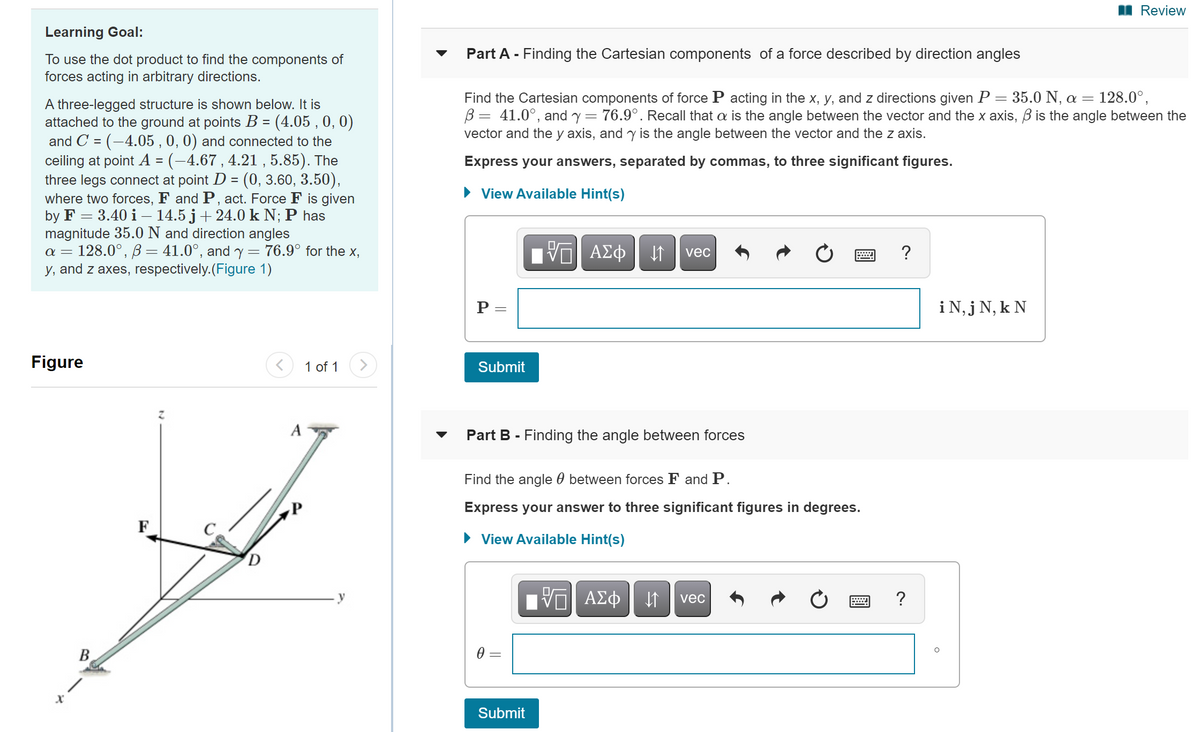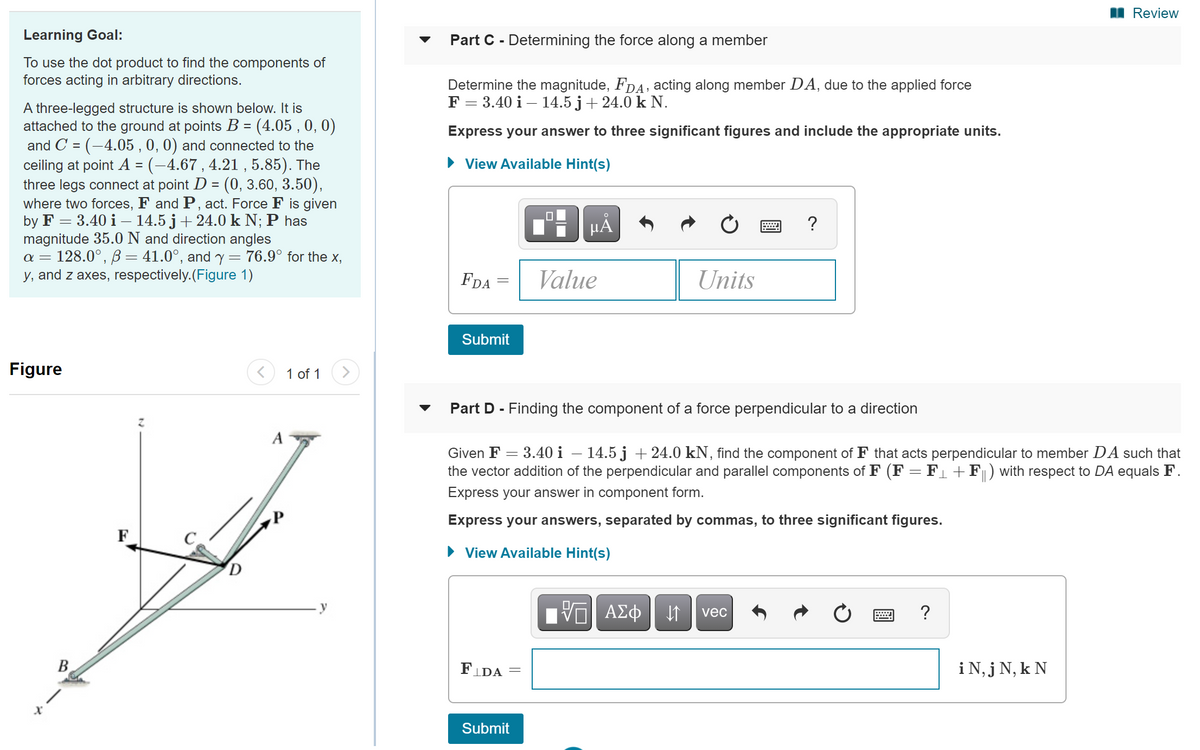Learning Goal: Part A - Finding the Cartesian components of a force described by direction angles To use the dot product to find the components of forces acting in arbitrary directions. Find the Cartesian components of force P acting in the x, y, and z directions given P = 35.0 N, a = 128.0°, B= 41.0°, and y= 76.9°. Recall that a is the angle between the vector and the x axis, B is the angle between the vector and the y axis, and y is the angle between the vector and the z axis. A three-legged structure is shown below. It is attached to the ground at points B = (4.05 , 0, 0) and C = (-4.05 , 0, 0) and connected to the ceiling at point A = (-4.67 , 4.21 , 5.85). The three legs connect at point D = (0, 3.60, 3.50), where two forces, F and P, act. Force F is given by F = 3.40 i – 14.5 j+24.0 k N; P has magnitude 35.0N and direction angles a = 128.0°, B= 41.0°, and y= 76.9° for the x, y, and z axes, respectively.(Figure 1) Express your answers, separated by commas, to three significant figures. • View Available Hint(s) vec P = i N, jN, k N Figure < 1 of 1 > Submit Part B - Finding the angle between forces Find the angle 0 between forces F and P. Express your answer to three significant figures in degrees. • View Available Hint(s) D. vec B. Submit 圓
Learning Goal: Part A - Finding the Cartesian components of a force described by direction angles To use the dot product to find the components of forces acting in arbitrary directions. Find the Cartesian components of force P acting in the x, y, and z directions given P = 35.0 N, a = 128.0°, B= 41.0°, and y= 76.9°. Recall that a is the angle between the vector and the x axis, B is the angle between the vector and the y axis, and y is the angle between the vector and the z axis. A three-legged structure is shown below. It is attached to the ground at points B = (4.05 , 0, 0) and C = (-4.05 , 0, 0) and connected to the ceiling at point A = (-4.67 , 4.21 , 5.85). The three legs connect at point D = (0, 3.60, 3.50), where two forces, F and P, act. Force F is given by F = 3.40 i – 14.5 j+24.0 k N; P has magnitude 35.0N and direction angles a = 128.0°, B= 41.0°, and y= 76.9° for the x, y, and z axes, respectively.(Figure 1) Express your answers, separated by commas, to three significant figures. • View Available Hint(s) vec P = i N, jN, k N Figure < 1 of 1 > Submit Part B - Finding the angle between forces Find the angle 0 between forces F and P. Express your answer to three significant figures in degrees. • View Available Hint(s) D. vec B. Submit 圓
International Edition---engineering Mechanics: Statics, 4th Edition
4th Edition
ISBN:9781305501607
Author:Andrew Pytel And Jaan Kiusalaas
Publisher:Andrew Pytel And Jaan Kiusalaas
Chapter8: Centroids And Distributed Loads
Section: Chapter Questions
Problem 8.73P
Related questions
Question

Transcribed Image Text:I Review
Learning Goal:
Part A - Finding the Cartesian components of a force described by direction angles
To use the dot product to find the components of
forces acting in arbitrary directions.
35.0 N, α-
Find the Cartesian components of force P acting in the x, y, and z directions given P
B = 41.0°, and y= 76.9°. Recall that a is the angle between the vector and the x axis, B is the angle between the
vector and the y axis, and y is the angle between the vector and the z axis.
128.0°,
A three-legged structure is shown below. It is
attached to the ground at points B = (4.05 , 0, 0)
and C = (-4.05 , 0, 0) and connected to the
ceiling at point A = (-4.67 , 4.21 , 5.85). The
three legs connect at point D = (0, 3.60, 3.50),
where two forces, F and P, act. Force F is given
by F = 3.40 i – 14.5 j+ 24.0 k N; P has
magnitude 35.0 N and direction angles
a = 128.0°, ß= 41.0°, and y= 76.9° for the x,
y, and z axes, respectively.(Figure 1)
Express your answers, separated by commas, to three significant figures.
• View Available Hint(s)
|ν ΑΣΦ
?
vec
P =
iN, j N, k N
Figure
1 of 1
Submit
Part B - Finding the angle between forces
Find the angle 0 between forces F and P.
Express your answer to three significant figures in degrees.
F
• View Available Hint(s)
D
Vo AEO
?
vec
B
0 =
Submit

Transcribed Image Text:Review
Learning Goal:
Part C - Determining the force along a member
To use the dot product to find the components of
forces acting in arbitrary directions.
Determine the magnitude, FDA, acting along member DA, due to the applied force
F = 3.40 i – 14.5 j+ 24.0 k N.
A three-legged structure is shown below. It is
attached to the ground at points B = (4.05 , 0, 0)
and C = (-4.05 , 0, 0) and connected to the
ceiling at point A = (-4.67 , 4.21 , 5.85). The
three legs connect at point D = (0, 3.60, 3.50),
where two forces, F and P, act. Force F is given
by F = 3.40 i – 14.5 j+ 24.0 k N; P has
magnitude 35.0 N and direction angles
a = 128.0°, B = 41.0°, and y = 76.9° for the x,
y, and z axes, respectively.(Figure 1)
Express your answer to three significant figures and include the appropriate units.
%3D
• View Available Hint(s)
μΑ
FDA
Value
Units
Submit
Figure
1 of 1
Part D - Finding the component of a force perpendicular to a direction
A
Given F = 3.40 i – 14.5 j + 24.0 kN, find the component of F that acts perpendicular to member DA such that
the vector addition of the perpendicular and parallel components of F (F = F +F) with respect to DA equals F.
Express your answer in component form.
Express your answers, separated by commas, to three significant figures.
F
• View Available Hint(s)
vec
?
B
FIDA
i N, j N, k N
Submit
Expert Solution
This question has been solved!
Explore an expertly crafted, step-by-step solution for a thorough understanding of key concepts.
This is a popular solution!
Trending now
This is a popular solution!
Step by step
Solved in 6 steps with 12 images

Knowledge Booster
Learn more about
Need a deep-dive on the concept behind this application? Look no further. Learn more about this topic, mechanical-engineering and related others by exploring similar questions and additional content below.Recommended textbooks for you

International Edition---engineering Mechanics: St…
Mechanical Engineering
ISBN:
9781305501607
Author:
Andrew Pytel And Jaan Kiusalaas
Publisher:
CENGAGE L

International Edition---engineering Mechanics: St…
Mechanical Engineering
ISBN:
9781305501607
Author:
Andrew Pytel And Jaan Kiusalaas
Publisher:
CENGAGE L